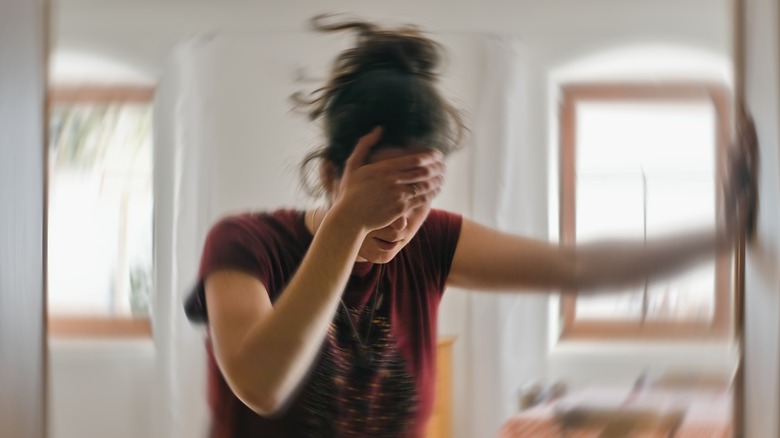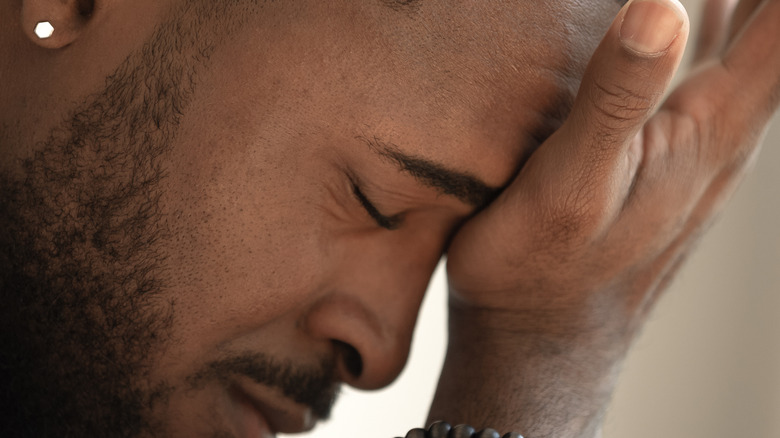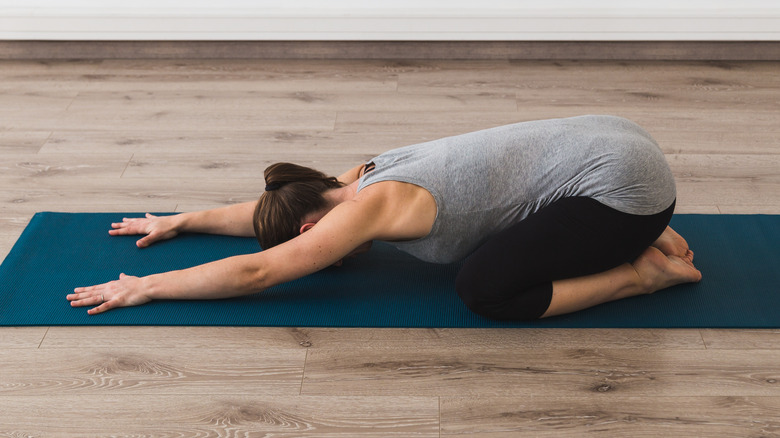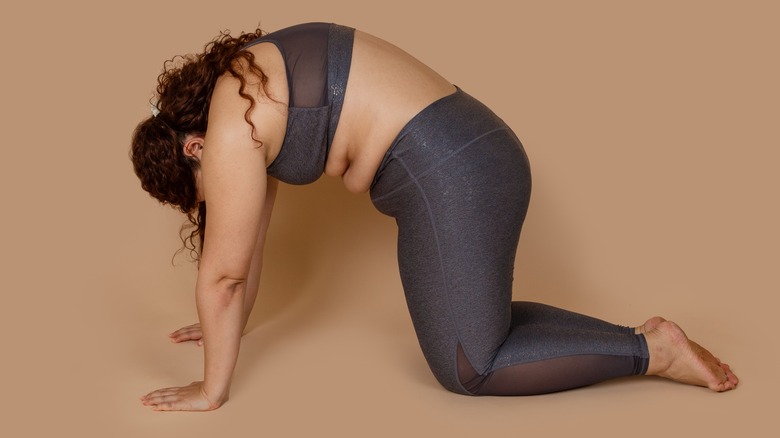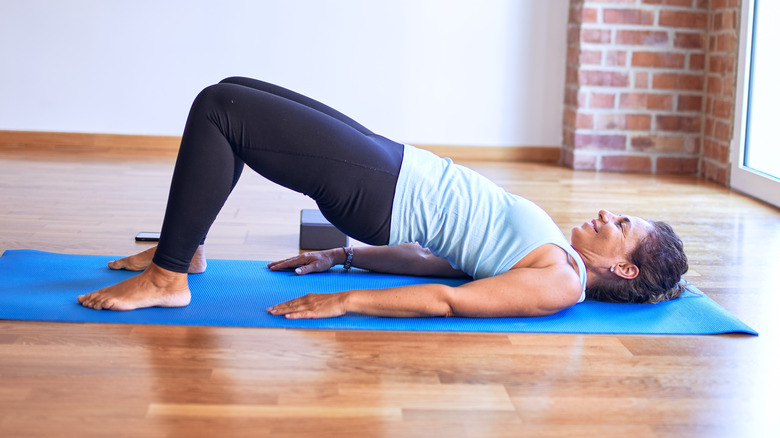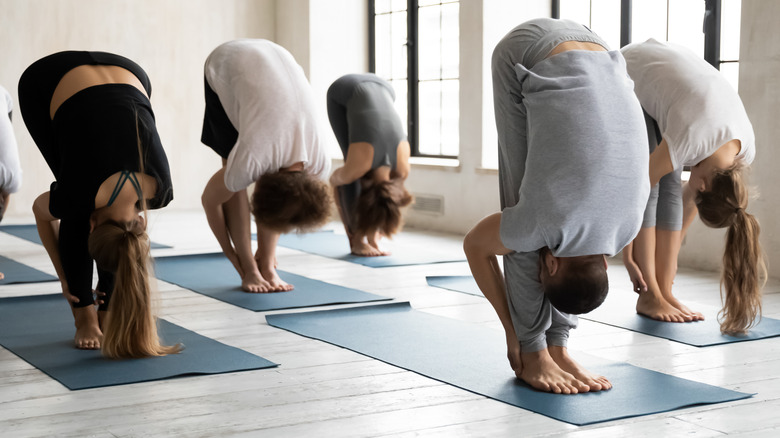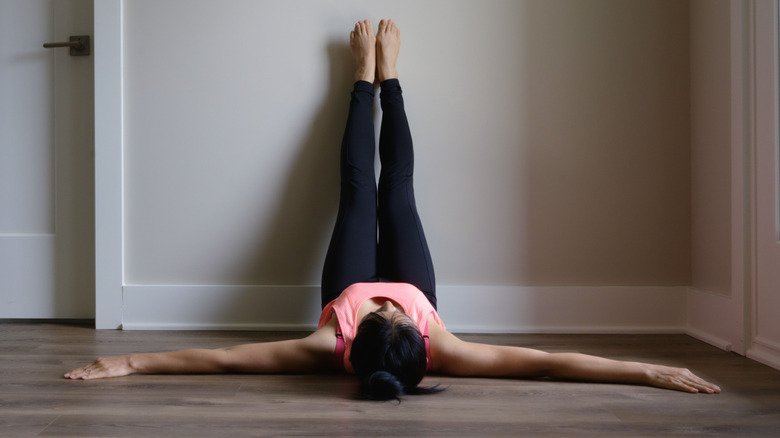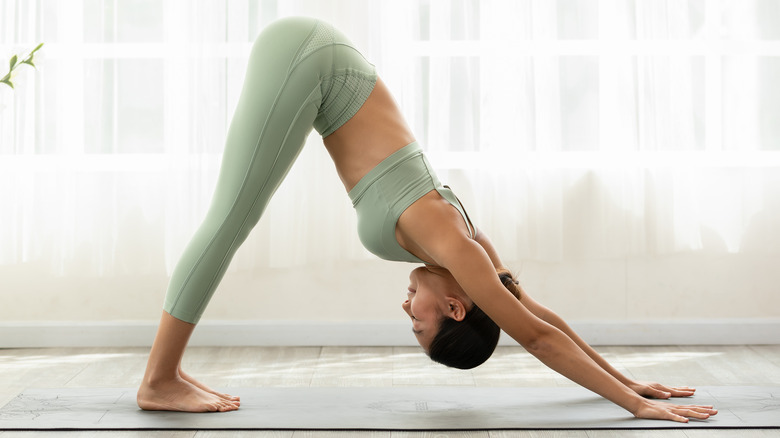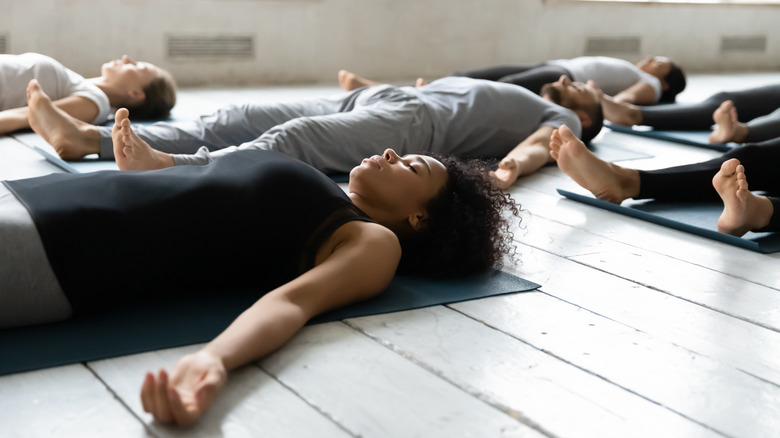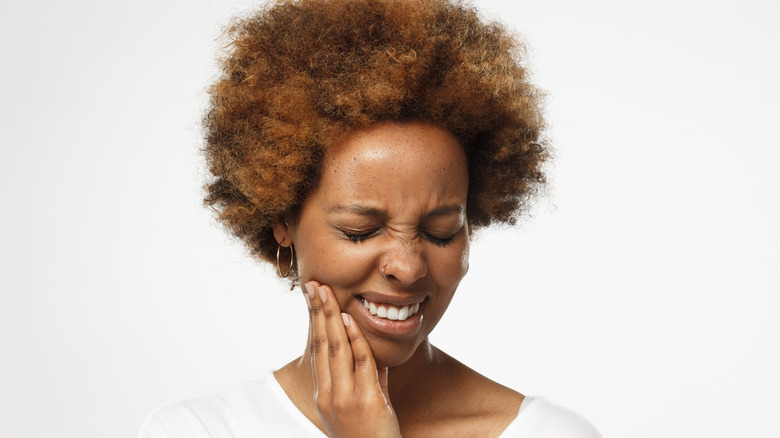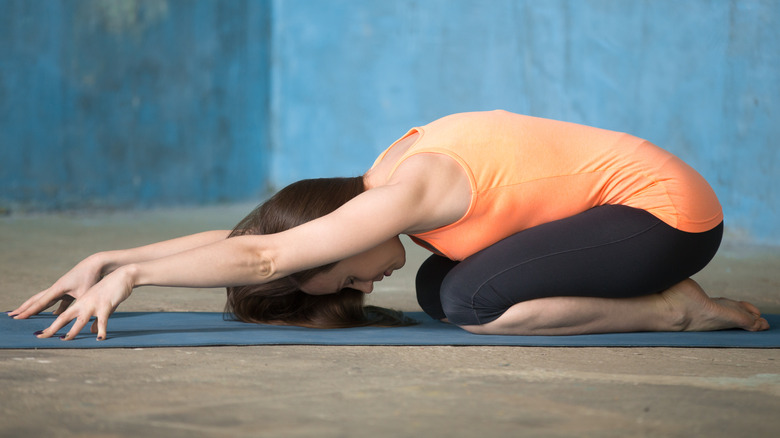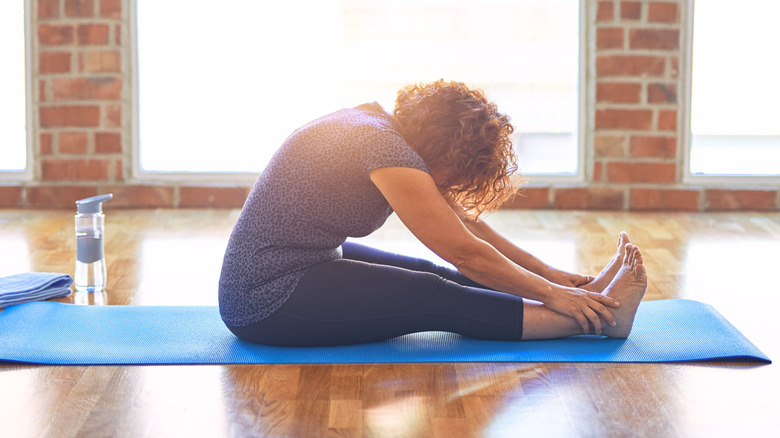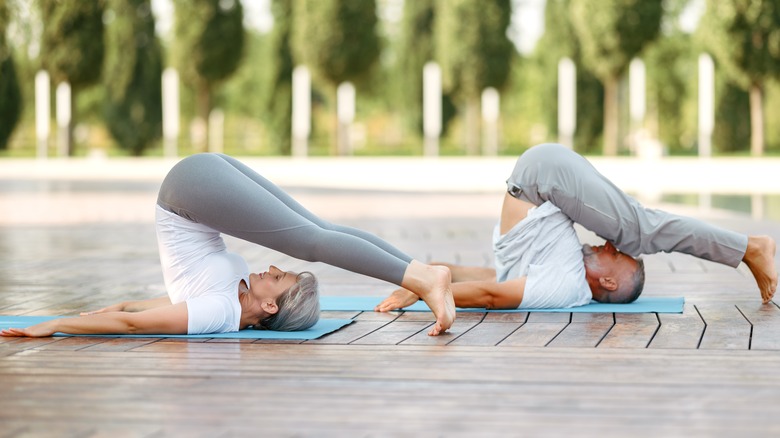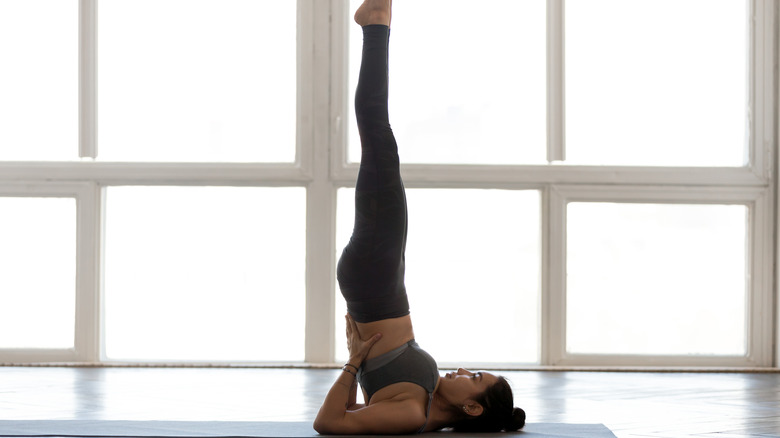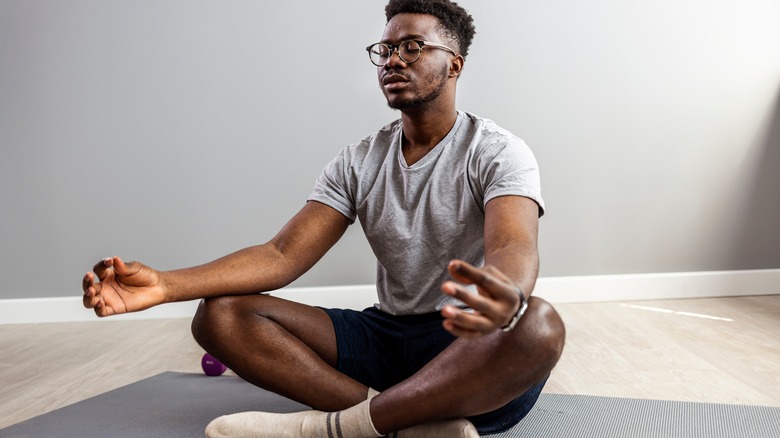The Best Yoga Poses To Try If You Have Chronic Migraines
There's no doubt about it — migraines suck. And they can be downright debilitating, getting in the way of your plans and everyday tasks. A migraine is more than just a headache, and includes symptoms such as sensitivity to light or sound, nausea, and vomiting that can last for hours or even days (via the Mayo Clinic). Sometimes people also experience an aura before or during a migraine attack, which is flashing light or other visual distractions.
Migraines are actually considered quite common and affect about one in every five women and almost one in every 15 men, according to the National Health Service. The exact cause of migraines are unknown, although some theories include stress, exhaustion, specific food or beverages, and the beginning of the menstrual cycle. Environmental factors and genetics may also be contributors. Often, when a migraine hits, taking over-the-counter pain medications like ibuprofen is recommended, as well as lying down or sleeping in a dark room.
There are alternatives, however, to dealing with chronic migraines. For example, let's explore some of the most effective yoga poses for alleviating that pounding in your head. Experts also point to a healthy lifestyle in helping to manage migraines.
Yoga and a healthy lifestyle can help
Isolating yourself in a dark room every time you have a migraine can feel a little defeating, and well — boring. Many people search for other ways they can help relieve symptoms or even stop migraines from happening in the first place. Some find that with a little observation, they can start to learn what their migraine triggers are, like a certain food or type of stress, for example. If you can actively avoid the things that seem to set off a migraine, you might be able to prevent them.
Also, the National Health Service recommends trying to live a healthy lifestyle as much as possible, including things like eating a healthy diet, limiting your caffeine and alcohol consumption, getting adequate sleep, drinking plenty of water, and exercising. In fact, some exercise can even help reduce or prevent symptoms of migraines, like yoga.
Research has shown that yoga can help reduce the intensity and frequency of chronic migraines (via the Journal of the Neuroscience of Rural Practices). Yoga is a mind and body practice that incorporates different movement, poses, breathing exercises, and mindfulness techniques. It can help reduce anxiety, depression, and stress — a big potential cause for migraines.
Child's pose
Child's pose is a relaxing shape that helps calm your nervous system. This soothing, gentle pose can help relieve migraine pain by reducing stress, as well as applying pressure to the forehead, since the pose requires the head to rest on the ground. To practice this posture, start by kneeling on the floor or a yoga mat. Allow your big toes to touch and slide your knees so that they are a little wider than hip-width distance apart.
As you exhale, fold forward and rest your upper body along the tops of your thighs. Extend your arms straight, reaching your fingertips away from your body and resting your arms along the ground, palms face down. Rest your forehead on the ground in front of your knees. It might feel nice to rock your head side to side to massage your forehead. Or Yoga Journal recommends placing a small ice pack on the ground to rest your forehead on to help reduce your migraine pain. You can stay in child's pose for a couple breaths or even several minutes, then release.
Cat/cow
Moving through the cat and cow postures helps reduce migraine symptoms because the movement can increase circulation while stretching your neck and spine, helping release any tension you might be feeling in the head and neck. To practice this pose, begin on your hands and knees, with your hands underneath your shoulders and your knees under your hips. Start with your head in a neutral position, softly gazing at the ground by your hands.
As you take a breath in, slowly start to look up toward the sky as you sink your belly button (and spine) toward the ground. As you exhale, gently tuck your chin into your chest — don't force it — and round your spine up toward the sky, arching your back. Move through these different shapes with every inhale and exhale, linking each breath with movement, and repeat this flow as many times as feels comfortable (via Yoga Journal).
Bridge pose
Bridge pose can help reduce stress felt in your upper body, which in turn can lessen the impact of a migraine. This pose also lifts the heart slightly above the head, which helps increase blood circulation to your brain and forehead and can help prevent a migraine episode. To practice this pose, start by lying on your back on a yoga mat or non-slip surface. If you have neck issues, Yoga Journal recommends putting a blanket underneath your neck and shoulders.
Bend your knees and place the soles of your feet on the ground, sliding them as close to your glutes as you can. As you exhale, press into your feet and slowly start to lift your hips off the ground, pressing them up toward the sky. Try to keep your thighs and feet parallel and stay engaged through your glutes to protect your lower back. Roll your shoulders underneath you, extend your arms straight under your body and interlace your fingers if you'd like.
Breathe deeply as you remain in this posture, anywhere from 30 seconds to one minute. When you're ready, release the pose with an exhale, freeing your fingers and slowly lowering your spine and hips back onto the ground.
Standing forward bend
Standing forward bend is thought to help prevent a migraine because it requires moving your head below your heart, increasing blood flow to the head and reducing stress in the body. This pose is also thought to help regulate hormones, so it's a good posture to practice if you suspect hormonal imbalance to be a contributing factor to your migraines.
To practice this pose, begin standing with straight posture on your yoga mat with feet under hips. Place your hands on your hips and as you exhale, hinge at the hips to bend forward. Imagine your spine lengthening and extending long. If you can, touch your fingertips or palms on the ground. If you can't reach, that's okay — simply cross your arms and grab hold of opposite elbows instead. Push your heels into the ground as you lift your hips toward the sky. Allow your head to hang and try not to engage any muscles in the neck — let gravity stretch your neck muscles.
Stay here for several deep breaths, then inhale back to standing when you are ready (via Yoga Journal).
Legs-up-the-wall pose
Legs-up-the-wall posture is a restorative pose that can not only prevent migraines, but also help balance blood pressure, and soothe depression and anxiety. For this pose, you will need to find a wall you can rest your legs on. You can lie directly on the ground or yoga mat — you may want to gather a pillow or one or more blankets to use for low back support. If you want to use blankets, Yoga Journal suggests folding one or more and placing them about 6 inches away from the wall.
Sit close to the wall, or on the edge of your cushy support, with your side touching the wall. Then, slowly begin to move your legs up the wall as you exhale and flatten your low back along the ground or your support. Lower your upper body, shoulders, and head to rest on the ground. Your glutes don't need to be touching the wall, just rest your heels and maybe some part of your legs against the wall — whatever feels best to you.
You may find that you need to adjust the distance you are away from the wall — if your muscles feel tight, sit further away from the wall or lower your cushion support if you are using one. Also, tall people tend to need to be a bit further away from the wall, while shorter folks can sit closer. Stay in this shape for five to 15 minutes, breathing deeply, then slowly roll to one side to release.
Downward facing dog
Downward dog can help reduce migraine symptoms because the pose is an inversion, just like standing forward bend, which brings your head below your heart. This increases blood circulation to the brain and forehead, helping reduce that terrible pounding migraine feeling. To practice this posture, you'll want to start on a yoga mat or non-slip surface. Begin on your hands and knees, in table top position. As you exhale, tuck your toes and slowly start to lift your hips up toward the sky.
Press your chest toward your thighs and your hips toward the back of the room. Gently press your heels toward the ground, without forcing them down. Focus on lengthening through your spine and extending your legs long. Try to relax your head and neck muscles, softly gazing down toward the ground (via Mind Body Green Movement). Stay in this shape for several deep breaths, or however long it feels comfortable to you, then gently release.
Savasana
Savasana, also known as corpse pose, is typically the last posture of a yoga class. This pose can help relieve migraine pain in the moment because it is a truly relaxing pose, helping you release stress and tension, which may be making your migraine worse. Savasana also asks you to focus on your breath and incorporate deep breathing, which can help increase oxygen to your brain and forehead (via Mind Body Green Movement).
To practice this pose, you will lie down on a yoga mat or blanket. Lie on your back, with your legs extended straight and your arms straight by your sides, palms face up to the sky. Mentally do a full body scan, intentionally relaxing every muscle in your body, especially the ones in the back of your neck, jaw, around your ears and eyebrows, and in your forehead. Focus on breathing deep into your lower belly. You may want to set a timer before you get into the pose, so you can stay in the shape for two to five minutes just focusing on your breath and nothing else.
Sukshma Vyayama
According to a study, Sukshma Vyayama is also helpful in relieving migraine symptoms (via the International Journal of Yoga). Sukshma Vyayama is a combination of different yogic movements aimed to help loosen joints and help release tension in the neck, face, and head (via WebMD).
To practice it, you'll begin with some simple jaw massage. Place three fingers on your jaw and move them back-and-forth toward your chin and neck, pressing in gently to massage the cheeks and jawline. If you find any areas that feel tight, spend a little extra time there. Make sure to do this on both sides. Then, open and close your jaw 8-10 times, then open your mouth and slide your jaw from side-to-side 8-10 times.
Next, you will move into a neck exercise: Take a deep breath in and gaze up toward the sky, then exhale and move your chin toward your chest. Repeat this motion 5-6 times, moving with your breath. Then, start to move your head clockwise one complete revolution, then counterclockwise for one turn. Inhale as your head moves up and exhale as it moves back down. Again, moving with your breath, repeat this motion about 5-6 times (via Medical News Today).
Rabbit pose
The scientific study in the International Journal of Yoga also found that rabbit pose (Shashankasana) was helpful for relieving migraines, reducing the severity and frequency of attacks. To practice this posture, you'll want to begin by sitting on the floor or a yoga mat. Extend your legs straight out in front of you and keep your posture as straight as you can. Slowly start to bend your right knee and bring your toes toward your glutes, tucking your leg under so that you are sitting on it, then do the same with the other leg.
Adjust yourself so that you are comfortable — you should be in a kneeling shape, resting your glutes on your heels. Place your hands on your thighs, and on your inhale, lift your arms up toward the sky. As you exhale, fold forward and reach your arms out in front of you, stretching through the fingertips and eventually resting your arms on the ground. Attempt to touch your nose or chin to the floor. Medical News Today recommends repeating this motion about 5-10 times, inhaling to reach up, and exhaling to fold forward.
Seated forward fold
Seated forward fold helps to stretch out your upper body, including your shoulders and neck muscles, which can help release built-up tension that can cause migraines. To practice this pose, begin seated on the floor or yoga mat. Lie your legs out in front of you and straighten through the knees. As you inhale, lift your arms up toward the sky, and as you exhale, hinge at your hips and fold forward, reaching your fingers toward your toes.
If you can reach your feet, grab a hold of them — but if not, no worries — simply rest your hands on your shins or legs, extending as far forward as feels comfortable. If your muscles feel really tight, you can slightly (or generously) bend the knees until you feel more secure. Focus on lengthening your spine as you fold your upper body (via Mind Body Green Movement). Take several deep breaths in this shape, then gently release.
Plow pose
You should feel comfortable doing shoulder stand before trying plow pose. This pose is more advanced because it requires some strength, flexibility, and balance to practice it safely. It is an inversion that is known to help reduce stress, fatigue, back pain, headaches, and insomnia (via Yoga Journal). To practice this pose, you will begin lying on your back on a yoga mat or non-slip surface. Bend your knees and start to engage your glutes, like you are going into bridge pose.
Roll your shoulders underneath you and place your hands on your lower back and hips for support. Slowly lift your legs up toward the sky, going into shoulder stand pose. Then, slowly extend your legs up and over your head until your toes rest on the ground behind the top of your head. Make sure to keep your legs as straight as you can and that your thighs are in front of your face (via Psych Central). Pause here and take a few deep breaths, then gently come out of the pose the way you entered, moving slowly to protect your spine.
Shoulder stand
Shoulder stand pose is generally not considered a beginner yoga pose, so if you feel unsure about practicing this one, it's okay to skip it or be sure to ask for help from a yoga teacher before trying it. It's also important to do a warm-up before going into this posture — practice a few of the previously mentioned poses instead of jumping into this one right away. This pose helps to increase blood flow to your brain and head, as well as soothe stress, anxiety, and fatigue.
To begin, first go into legs-up-the-wall pose. Then, gently move into plow pose. When you are ready, slowly bend your knees so that they hover near your head. Keeping your hands on your hips and low back for support, slowly start to lift your legs up toward the sky, extending your legs as straight as you can. Pause here for a moment and try to relax and focus on breathing deep. To come out of this shape, return to plow pose, bend your knees, and gently roll your spine back to the ground (via Mind Body Green Movement).
Pranayama (breathing techniques)
One of the most beneficial parts of any yoga pose or practice is pranayama, or deep breathing. Practicing yoga along with breathing exercises can help provide relief from pesky migraines and might even help prevent them in the first place (via Psych Central). They can also help reduce stress, enhance sleep, increase awareness, support your brain and lungs, and even reduce high blood pressure.
Pranayama refers to the ancient yogic practice of focusing on and controlling your breath. There are many different types of breathing exercises you can try. Some techniques include alternate nostril breathing; victorious or ujjayi breath; "honeybee" humming breath; or breath of fire, also known as bastrika (via Healthline). For example, to practice bumblebee breath, plug your ears closed, close your eyes, and take deep inhales and exhales. Every time you exhale, softly make a "humm" sound on the back of your throat. You can practice any type of pranayama technique you like during your yoga practice or a specific yoga posture, or simply during meditation.
